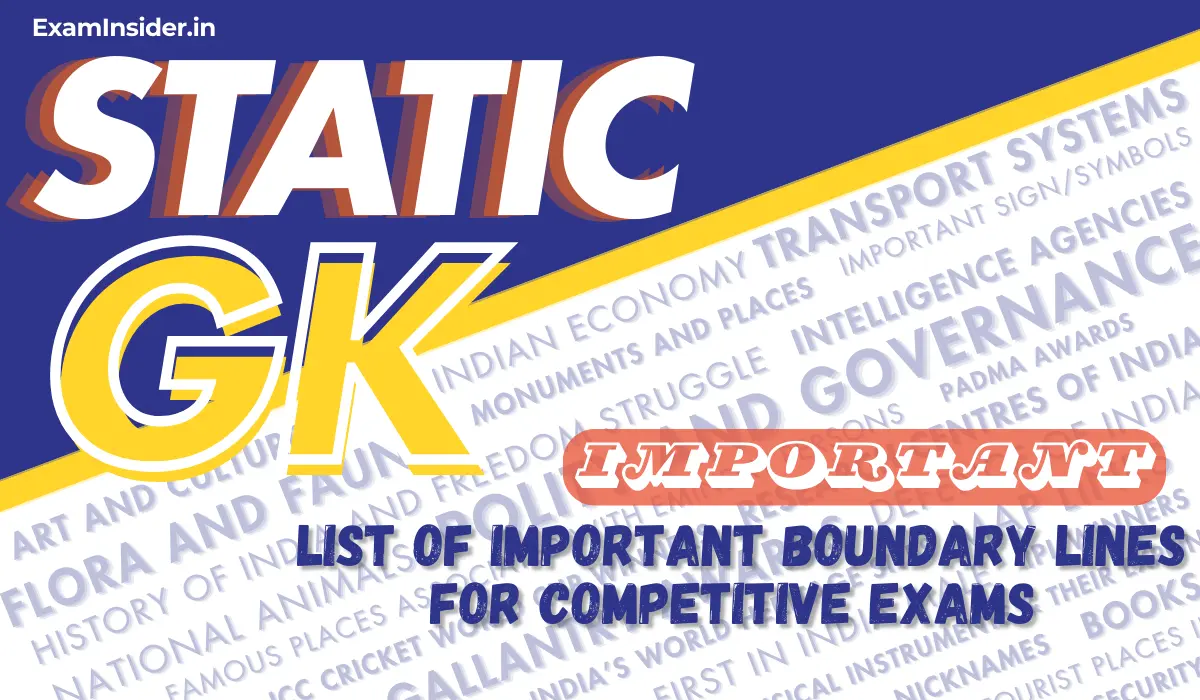Boundary lines between countries not only define territories but often reflect historical conflicts, political agreements, and cultural divides. Many of these borders were drawn as a result of wars, treaties, or negotiations, and they hold significant importance in the study of global geography and international relations. For competitive exams like UPSC, SSC, and others, questions about these boundaries often arise due to their geopolitical relevance. In this blog, we will discuss the most important boundary lines around the world, their historical significance, and the countries they divide.
List of Important Boundary Lines for Competitive Exams:
| Boundary Name | Countries Divided | Important Fact |
|---|---|---|
| Radcliffe Line | India and Pakistan | Drawn in 1947 during the Partition of India by Sir Cyril Radcliffe; it led to mass migration and violence. |
| Durand Line | Pakistan and Afghanistan | Created in 1893 by British diplomat Sir Mortimer Durand; it is still a source of conflict between Pakistan and Afghanistan. |
| 38th Parallel | North Korea and South Korea | Divides the Korean Peninsula after World War II; became the Korean Demilitarized Zone (DMZ) after the Korean War. |
| 49th Parallel | USA and Canada | Agreed upon in 1846 through the Oregon Treaty; it forms part of the world’s longest undefended border. |
| McMahon Line | India and China | Proposed by British India in 1914, this boundary is a subject of dispute between India and China in the eastern sector. |
| Hindenburg Line | Germany and Allied Powers | A German defensive position built during World War I; its breach by Allied forces contributed to Germany’s defeat. |
| Maginot Line | France and Germany | A line of defensive fortifications built by France to deter German invasions; bypassed by Germany in World War II. |
| Oder-Neisse Line | Germany and Poland | Established after World War II as Poland’s western border, it marked the territory gained by Poland at Germany’s expense. |
| Siegfried Line | Germany and France | A German defensive line built opposite the Maginot Line during World War II. |
| 17th Parallel | North Vietnam and South Vietnam | Temporarily divided Vietnam into North and South as per the Geneva Accords in 1954; this line ceased to exist after the Vietnam War. |
| Green Line | Cyprus | A demilitarized zone that separates the Turkish-controlled northern part of Cyprus from the Greek-controlled south, established in 1974. |
| Purple Line | Israel and Syria | Marks the ceasefire line established after the 1973 Yom Kippur War; it separates the Golan Heights from Syria. |
| Blue Line | Israel and Lebanon | A United Nations demarcation line established in 2000 to verify Israel’s withdrawal from southern Lebanon. |
| Mason-Dixon Line | USA (Pennsylvania and Maryland) | Historically, this line is associated with the division between the Northern and Southern United States, especially during the Civil War era. |
| Curzon Line | Poland and Soviet Union | Proposed in 1919, this line became Poland’s eastern border after World War II, following Stalin’s annexation of eastern Poland. |
| Linea Gotica (Gothic Line) | Italy | A German defensive line in northern Italy during World War II, breached by Allied forces in 1944. |
| Attila Line | Cyprus | Also known as the Green Line, this boundary was established after Turkey’s invasion of Cyprus in 1974, dividing the island between Greek and Turkish zones. |
| Panjshir Line | Afghanistan | A strategic boundary during the Soviet-Afghan War, marking resistance control over the Panjshir Valley. |

